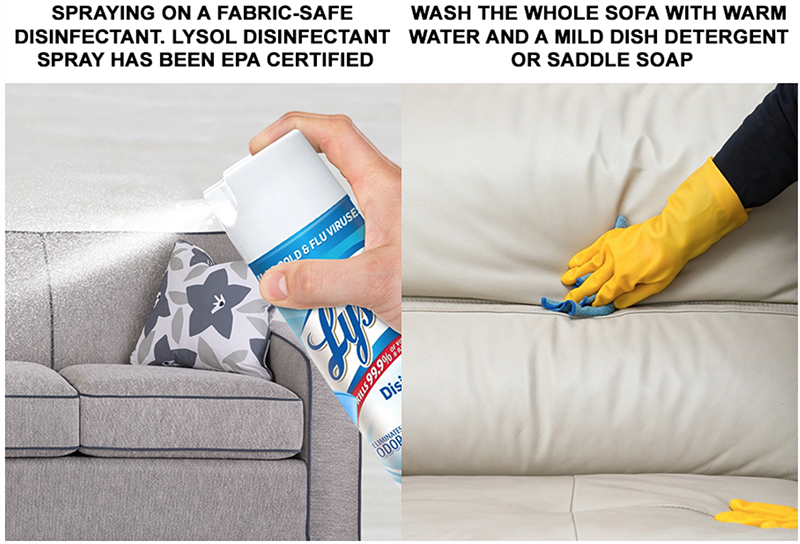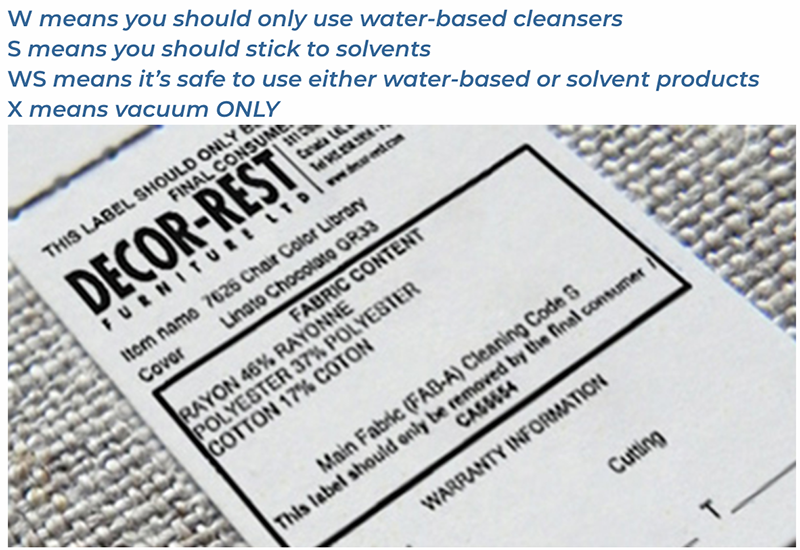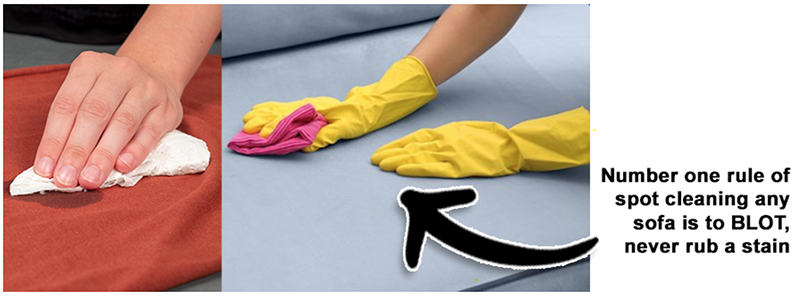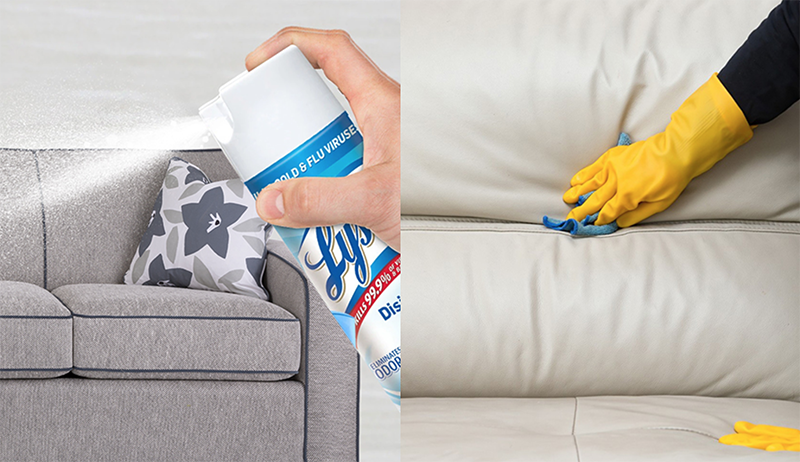Whether it’s from spending more time than ever in our homes or a desire to deep clean everything, there’s a pretty good chance your sofa is due for a little TLC. But, of course, maintaining and disinfecting fabric and leather sofas isn’t as straightforward as washing the floors. So we’ve rounded up everything you need to know about taking care of your sofa, from regular cleaning to disinfecting to spot cleaning.
Regular Cleaning
If you want to keep your sofa looking great, then regular cleaning every couple of weeks is a must. It won’t take too long, and it makes such a difference. Fabric upholstery can be easily cleaned by vacuuming your sofa. Remove pillows and cushions and vacuum all surfaces using the upholstery attachment, which has a soft lint-trapping strip on the edge. (Tip: Always make sure your vacuum attachments are clean before you start!) Apply even pressure in long, even strokes, as vigorous vacuuming can grind in stains. Follow that up with the crevice tool (the one with the flattened, narrow end) around any joints, crevices, tufting, piping and any other spots where dust and debris can get trapped. If you notice a bit of surface dirt on your sofa, a soft brush can loosen and lift it. Follow that up with vacuuming to ensure all dirt is removed. Cleaning a leather sofa is a bit different, because leather needs to be dusted and conditioned. Vacuum the crevices and under the cushions to remove dust, dirt, crumbs and other debris, and then dust the sofa, cushions and pillows with a microfibre cloth. Once a month, you’ll also need to apply a leather cream to ensure the material stays soft and moisturized. After you’re done cleaning your sofa, don’t forget to fluff cushions and pillows so they look their best.
Disinfecting a Sofa
Disinfecting is more important than ever, but while cleaning hard surfaces is routine by now, a sofa is a bit more complicated. While evidence suggests there’s a fairly low risk of contracting coronavirus from a soft surface, like a sofa, it can’t hurt to periodically disinfect the soft surfaces in our homes — especially if it gives you peace of mind.
For fabric upholstery, you’ll want to start by vacuuming the sofa as you would for a general cleaning. (Be sure to wipe the vacuum and attachments after use if you have a concern about coronavirus exposure.) Follow this by spraying on a fabric-safe disinfectant. Lysol Disinfectant Spray has been EPA certified to kill the novel coronavirus, and the company recommends it for disinfecting sofas, so it’s an obvious option — if you can find it.
It’s worth noting that in order to sanitize soft surfaces, you typically need to apply enough disinfectant that the surface remains wet for five minutes. Each product will provide instructions on disinfecting versus sanitizing, so be sure to read the label carefully.
Disinfecting a leather sofa takes a bit more time, but it’s pretty simple. You just need to wash the whole sofa with warm water and a mild dish detergent or saddle soap. Soap dissolves the fat membrane on coronavirus, so as long as you apply a good amount of soap to the leather upholstery and let it sit a minute before wiping off with clean, warm water (you may need a couple of rounds of rinsing), you should be effectively killing the virus. Since soap does strip oils, you’ll want to follow washing with a leather cream.
One last point on disinfecting: If your sofa has any wood or metal or parts or trim, it’s a good idea to spray or wipe down those areas daily with a disinfectant wipe. Make it part of your routine when you’re wiping doorknobs, light switches and other high-touch surfaces, and it’ll become second nature in no time.

Spot Cleaning
Spills and stains are inevitable, so it’s a good idea to have what you need to remove them on hand so you can clean them when they’re fresh.
Be sure to read the manufacturer’s cleaning instructions and use the right products for the upholstery. The tag on your sofa will have a cleaning code that indicates which type of cleansers are safe to use.

The number one rule of spot cleaning any sofa is to blot, never rub a stain. Not only will rubbing grind the stain deeper into the material and likely result in a larger stain, it can also damage some materials irreparably. You always want to start by blotting with a dry paper towel or lint-free cloth to lift as much of the stain as possible before going in with any detergent or cleanser.

Velvet is especially prone to damage during cleaning, particularly silk, rayon and acetate velvet, which can be crushed, so it’s best to leave cleaning these materials to a pro. If that’s not possible given COVID-19 restrictions, call a professional cleaner and ask if they can walk you through it for a consulting fee. If, on the other hand, you have a cotton or polyester velvet sofa, you can safely spot clean it by blotting lightly with a paper towel and gentle detergent. Never press down hard on velvet upholstery.
Cotton, polyester, linen and microfibre are more forgiving as materials, so you can apply a bit more pressure if needed — but start gently. After blotting with a dry, lint-free cloth or paper towel, use either a mild detergent and a wet cloth or a solvent applied to a dry cloth (depending on what’s appropriate for your upholstery) and continue blotting until the stain has lifted.
Spot cleaning leather sofas requires special products. In the case of very light stains, you may be able to remove them with the leather cream you use for monthly conditioning. If that doesn’t work, saddle soap (which is specifically made for leathers) is a great option — dip a microfibre cloth in warm soapy water and blot or gently wipe the stain to lift it.
Removing Ink Stains
If you’ve ever had an ink stain on your sofa, you know that’s a bit of a different beast. They’re tough to remove, but if you’re lucky, you might just get that spot out. Keep in mind speed is your friend with an ink stain — the fresher it is, the easier it’s going to be to clean.
If the pen mark is fresh, step one is carefully blotting it with a dry paper towel to soak up as much ink as possible.
For fabric upholstery, the best products for lifting ink are rubbing alcohol (which is water-based) or dry cleaning solvent. Apply with a dry cloth, dabbing the stain to lift the ink. If that doesn’t work, you may need to resort to gently rubbing at the ink, but this can spread the stain, so you may want to test this very carefully at the edge of the stain. And keep in mind you definitely don’t want to rub at any stain on velvet upholstery.
If you have a leather sofa, ink stains are especially difficult to remove. The best option for cleaning an ink stain from leather is a commercial-grade leather care product specifically made for removing ink stains. Always test products on an inconspicuous part of the sofa before use, and follow the instructions on the bottle. Be sure to apply leather cream after cleaning to put moisture back into the leather.

